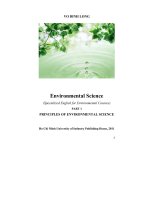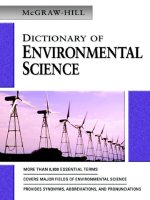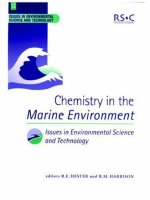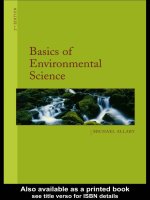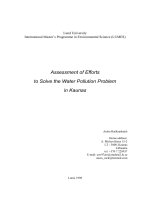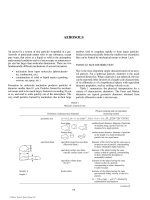Environmental Science: Marine energy
Bạn đang xem bản rút gọn của tài liệu. Xem và tải ngay bản đầy đủ của tài liệu tại đây (2.42 MB, 57 trang )
Introduction to
Environmental Science
Prof : Nguyen Xuan Cu
Group 7
1. Do Thi Ngoc Bich
2. Enkhbayar batsukh
3. Pham Thanh Huong
4. Do Thi Ngoc Khanh
5. Nguyen Hanh Mai
6. Tran Thu Trang
7. Trinh Thi Thu Trang
Marine energy
Content
1
2
3
Definitions
and overall
potential
Some
kinds of
marine
energy
Potential
of
Vietnam
I. Definitions and overall potential
• Energy is a quantity that is often understood as
the ability a physical system has to do work on
other physical systems ( in physics )
• Marine energy ( marine power /ocean energy /
ocean power) refers to the energy carried by
ocean waves, tides, salinity, and ocean
temperature differences ( Wikipedia )
• Larger conception : Energy that belongs to
the ocean
Potential
• The oceans have a tremendous amount of energy and are close to most
concentrated populations. Many researches show that ocean energy has
the potential of providing for a substantial amount of new renewable
energy around the world
• Theoretical potential
50000
40000
Potential TW/h
30000
20000
10000
0
Osmotic power
Tidal /current energy
II. Some kinds of marine energy
1.Wave energy
a. General view
•. Waves are generated by wind passing over the surface of the
sea, there is an energy transfer from the wind to the waves.
• Wave power is the transport of energy by
ocean surface waves, and the capture of that
energy to do useful work (electricity generation
, water desalination, or the pumping of water )
• In general, larger waves are more powerful but
wave power is also determined by wave speed,
wavelength, and water density.
Wave power devices can be categorized
in terms of
Location
b. Some examples
• Salter’s Duck ( Nodding Duck )
• The Pelamis Wave Energy
Converter
The machine is made up of
connected sections which flex and
bend as waves pass; it is this
motion which is used to generate
electricity.
•
Aquamarine Power’s Oyster
technology captures energy in
nearshore waves and converts it
into clean sustainable electricity.
• Oyster is a wave-powered
pump which pushes high
pressure water to drive an
onshore hydro-electric turbine.
LIMPET (Land Installed
Marine Power Energy Transmitter )
c. Advantages vs Disadvantages
• The energy is free - no fuel needed,
no waste produced.
• Not expensive to operate and
maintain.
• Can produce a great deal of energy.
• Waves that are caused by winds can
be very predictable
• Depends on the waves - sometimes you'll get
loads of energy, sometimes almost nothing.
• Needs a suitable site, where waves are
consistently strong.
• Some designs are noisy. But waves are noisy
too so it is unlikely to be a problem.
• Must be able to withstand very rough weather
d. Locations with the most potential
• Western seaboard of Europe
• the northern coast of the UK
• the Pacific coastlines of North and
South America
• Southern Africa
• Australia, and New Zealand
The north and south temperate
zones have the best sites for
capturing wave power. (the
prevailing westerlies in these
zones blow strongest in winter)
2. Tidal energy
a. General view
•. Tides are the rise and fall of sea levels caused by the combined
effects of the gravitational forces exerted by the Moon and
the Sun and the rotation of the Earth.
•. Tidal power / tidal energy, is a form of hydropower that converts
the energy of tides into electricity or other useful forms of power.
b. Three main kinds of tidal energy
• Tidal barrage is a dam-like structure used to
capture the energy from Masses of water moving
in and out of a flight or river due to Tidal forces.
• Tidal stream generator
A tidal stream generator/ tidal energy converter (TEC) is
a machine designed to extract energy from run of river or
tidal estuarine sites.
Certain types of
these
machines
function very much
like
underwater wind
turbines, and are
thus often referred
to as tidal turbines.
• Dynamic tidal power (DTP) is a new and
untested method of tidal power generation. It
would involve creating large dam-like of 30 to 60
km forming a large 'T' shape.
DTP would interfere
with
coast-parallel
oscillating tidal waves
which run along the
coasts of continental
shelves,
containing
powerful hydraulic
currents
(common
in e.g. China ,Korea,
and the UK).
c. Advantages vs Disadvantages
• Tidal energy is renewable
• It is free once the dam is
built
and
the
maintenance
costs
associated with running a
tidal station are relatively
inexpensive
• Tides are easy to predict
• Tidal power is not
currently economically
feasible
(costs
of
building a dam) except
kinds
using
tidal
turbines .
• affect
the
aquatic
ecosystems, transport
or fishery
3. Current energy
a. What is ocean current ?
• The ocean currents are driven by wind and solar heating
of the waters near the equator, though some ocean
currents result from density and salinity variations of
water.
• These currents are relatively constant and flow in one
direction only
b. Some examples
Submerged water turbines
similar to wind turbines
Shroud turbines
( concentrators )
• The Vivace :
The vortices caused by currents push and pull
the passive cylinder up and down on its
springs, creating mechanical energy. Then, the
machine converts this energy into electricity.
Systems could be sited on river beds or
suspended in the ocean
